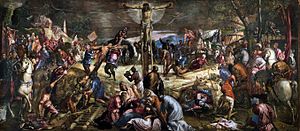The Crucifixion (Tintoretto)

|
| The crucifixion |
|---|
| Jacopo Tintoretto , 1566 |
| Oil on canvas |
| 536 × 1224 cm |
| Scuola Grande di San Rocco |
The Crucifixion is a painting by Jacopo Tintoretto . It is located in the Sala dell'Albergo of the Scuola Grande di San Rocco in Venice , above the boardroom of the brotherhood. It forms the climax of a passion cycle, which consists of the paintings: "Christ before Pilate", "The Crowning of Thorns", "Walk to the Calvary" and the "Crucifixion" described here.
Type of execution
Tintoretto carried out extensive preliminary studies for this painting. Design drawings have been preserved in Florence , London and Rotterdam . However, he sketched the overall composition directly on the canvas , as demonstrated during the last restoration work.
content
In the middle of this canvas painting, which was completed in 1566, the dominant figure of Christ crucified on the cross is depicted. At the feet of Christ, who fights in tragic loneliness against the stormy sky, is the group mourning Christ, which has been placed in the foreground by lighting. The carefully constructed lines of flight are characteristic of this painting.
In this painting the groups of riders, the mourning group at the feet of Jesus and Jesus himself are highlighted, while the crowd is lost in increasingly nervous sparks of light and in an increasingly desolate, windswept landscape.
Pay and fame
This painting, for which Tintoretto was paid 250 ducats on March 9, 1566 , immediately became famous, as can be proven by numerous engravings . The artists of the 17th century, such as Anthonis van Dyck and Peter Paul Rubens , also studied the work very carefully. The most famous engraving dates from 1582 by Agostino Carracci for Cardinal Ferdinando de Medici.